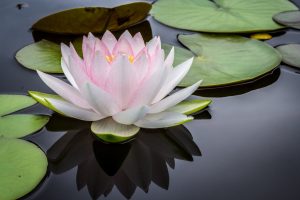
Photo by Jay Castor on Unsplash
There are many different strands to yoga, for example, ethical and cleansing practices, meditation, breath-work, chanting and even working towards experiencing a higher state of consciousness. The ASANAS are the physical poses which most of us will readily identify as yoga practice.
When these yoga poses are laced together in such a way that breath and movement are synchronised, we create a movement meditation which can be so absorbing, that the experience cleanses the mind of intrusive thoughts and constant internal chatter.
On completion of the sequences we are often left feeling not just physically balanced and more free in our bodies but also more settled in our mind.
HOW TO MAKE THE MOST OUT OF YOUR YOGA CLASS TO ACHIEVE A CALM MIND
Aim to arrive in plenty of time to not only set up, but to psychologically switch off thoughts of work, responsibilities, stresses etc.
Having your own yoga mat can help you get in mode as the laying of your mat, your own personal haven, can become a symbolic gesture that you are carving out precious time for just you. This is your space, it’s sacred and unwanted visitors are not welcome.
Be mindful in every movement and position and with every breath. This means you tune inward to your body, listen to what your body tells you and respond appropriately and sensitively. To achieve a calm mind we breath through the nose, long, slow and resonant. This is called the Ujjayi Breath. It has a particular quality which involves constricting the back of the throat which makes the breath sound gutteral (almost like the prelude to a snore). This serves to slow the respiration rate right down, slows the heart rate and feeds back through the nervous system that we are safe and therefore calm.
The following link will direct you to a youtube clip which will demonstrate how to master the Ujjayi Breath. https://www.youtube.com/watch?v=IQrsJ-yZWV8
Using the breath in for open, upward and lifted movements and the out-breath for closed, inward and lowering movements becomes an intuitive practice and so the movement of the body from pose to pose integrates seamlessly with the breath.
The use of Drishti points/gazing points can be yet another aspect of the physical practice which helps the yogi internalise the feelings and feedback coming from the body and helps to keep out external distractions. The gaze points may be the 3rd eye/area between the brows, the tip of the nose or a physical external source such as a mandala or candle light.
And so, if you are one of those who finds sitting for meditation practice or generally trying to relax and switch off difficult or frustrating then movement meditation with yoga may offer you the benefits of a classical meditation practice without the battle of sitting for extended periods. These moments of stillness can be enjoyed as you pause your breath at the peak of your inhalation and linger in the empty feeling at the bottom of your exhalation.
Savasana is the relaxation part of class which typically comes at the end of the session. We give ourselves permission to lie down or sit in a restful position, perhaps using props such as cushions, blocks or blankets to support our joints and keep warm, dim the lights and ‘switch off any external distractions’.
Here, we allow the body to absorb the benefits of the poses. We often bring the focus back to the breath to avoid the internal dialogue from pushing in. It is in this zone of stillness that deep feelings have the space to emerge and we might experience ‘letting go of things’ which are holding us back, entangling us perhaps, or making us unhappy. Therefore this time is so precious and the potential benefits so bountiful that wasting this time by diving straight into planning, ruminating or thinking in any guise should be actively discouraged.
This is your time for being. NOT DOING!

